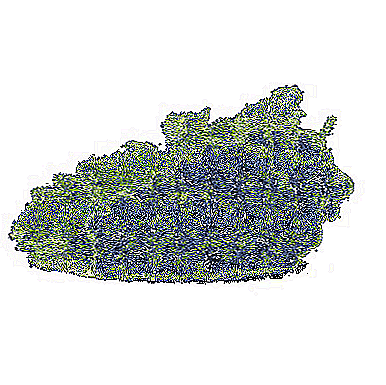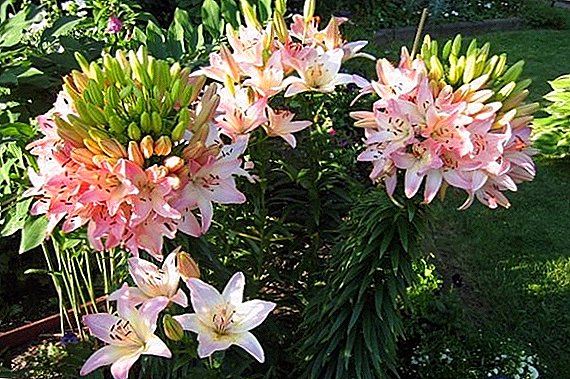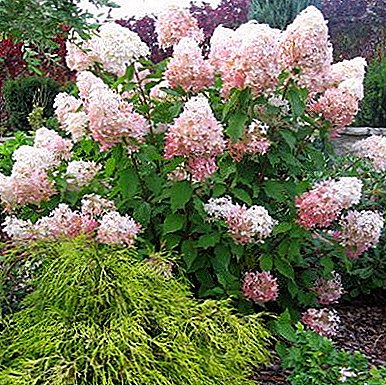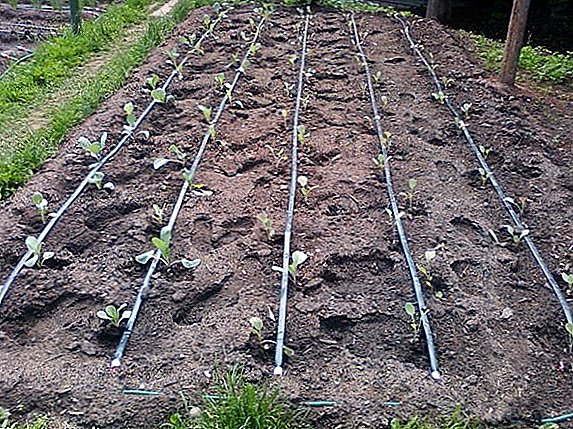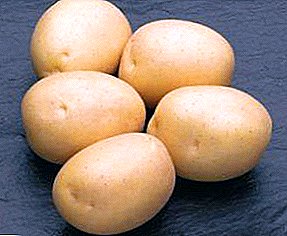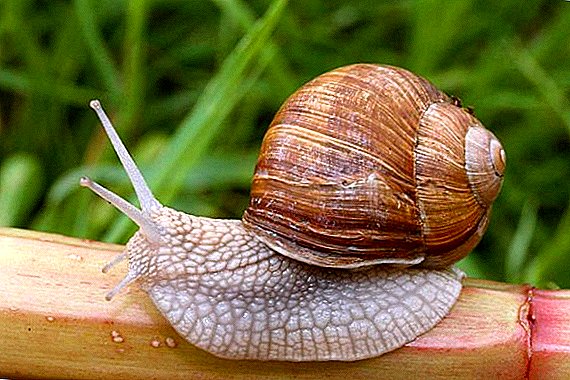 Grape snail It is so named because of the harm that it causes by eating grapes. Snails were eaten since ancient times, not considering them as a delicacy, but rather, quite the contrary, since they were available to any segment of the population.
Grape snail It is so named because of the harm that it causes by eating grapes. Snails were eaten since ancient times, not considering them as a delicacy, but rather, quite the contrary, since they were available to any segment of the population.
The appearance of the snail
 The body of a snail is, roughly speaking, a big leg and head. It is very flexible and elastic, the color is beige-gray, whitish-brown or yellowish-gray. There are many folds on the body, which, when moving, increase the area of the lower surface of the leg, helping to overcome long distances. The leg of an adult individual, in natural conditions, can stretch up to 9 cm, but grape snails grown at home grow to gigantic sizes.
The body of a snail is, roughly speaking, a big leg and head. It is very flexible and elastic, the color is beige-gray, whitish-brown or yellowish-gray. There are many folds on the body, which, when moving, increase the area of the lower surface of the leg, helping to overcome long distances. The leg of an adult individual, in natural conditions, can stretch up to 9 cm, but grape snails grown at home grow to gigantic sizes.
On the head are located: the oral opening and two pairs of antennae-tentacles. One pair, the front one, is intended for the sense of smell, the second one, located behind the eye, has light-sighted eyes, which do not distinguish colors, but see the outlines of objects at a distance of one centimeter. The tentacles of the snails are very sensitive and at the slightest touch they are immediately removed inside. The shell of the snails fully accommodates their torso, twisted counterclockwise. The shell color is usually yellow-brown or white-brown, and the ribbed surface allows the snails to accumulate moisture.
Features of the life cycle of a snail
 Snails are active in the warm season: from April, May and until the first frost. With the onset of cold weather, they fall into hibernation (hibernation), burrow into the soil, tearing a depression up to 30 cm, where they wait for the cold. Usually in nature, the snail does not change its "hole". During the wintering period, the mollusks close the "entrance" to the shell with a slime valve, leaving little access for air. In the spring, the snails push out the protective film and begin active livelihoods and search for food. Various plants and their fruits, berries, this is what grape snail eats, although they often eat the soil. For example, immediately after leaving anabiosis, the snails, eating a small amount of earth, restore the microflora of the digestive system so that coarser food is easier to digest.
Snails are active in the warm season: from April, May and until the first frost. With the onset of cold weather, they fall into hibernation (hibernation), burrow into the soil, tearing a depression up to 30 cm, where they wait for the cold. Usually in nature, the snail does not change its "hole". During the wintering period, the mollusks close the "entrance" to the shell with a slime valve, leaving little access for air. In the spring, the snails push out the protective film and begin active livelihoods and search for food. Various plants and their fruits, berries, this is what grape snail eats, although they often eat the soil. For example, immediately after leaving anabiosis, the snails, eating a small amount of earth, restore the microflora of the digestive system so that coarser food is easier to digest.
In the daytime, mollusks prefer to sit in wet places, under large stones or in dense thickets, under a pile of leaves. The activity of snails is manifested mainly in rainy weather and after it. On dry and hot days, the specimens tighten with a thin film the mouth of the shell and wait out uncomfortable conditions. Some members of the family stick to the bark of the trees, waiting out the period of drought. How long do snails live? On average, up to eight years, but if not eaten by natural enemies, such as hedgehogs, it can live up to twenty years.
Did you know? Snails - fantastic creatures, because their ability to regenerate surpassed lizards. If the latter is able to grow only the tail, bitten off by a predator, then the mollusks can grow and tentacles, and part of the head a maximum of a month.
Snail use
 Growing snails is aimed at eating them. Snail meat today is considered a great delicacy and has certain beneficial properties: it contains calcium, iron, magnesium, phosphorus, copper, zinc; a large amount of protein and vitamins of group B, except for them vitamins: E, K, A, PP. Snails are useful for pregnant women, being a source of calcium and magnesium, children for growth, religious people who keep fast as a source of protein. France and Italy are especially famous for their snail dishes.
Growing snails is aimed at eating them. Snail meat today is considered a great delicacy and has certain beneficial properties: it contains calcium, iron, magnesium, phosphorus, copper, zinc; a large amount of protein and vitamins of group B, except for them vitamins: E, K, A, PP. Snails are useful for pregnant women, being a source of calcium and magnesium, children for growth, religious people who keep fast as a source of protein. France and Italy are especially famous for their snail dishes.
Breeding snails is also associated with medicine. In particular, snails are used to obtain broncho-relaxants and lectins. Of the useful substances in the composition of snails, pharmaceuticals produce drugs that increase immunity, anti-inflammatory drugs and wound healing, as well as sedatives for the treatment of nervous disorders. Doctors recommend to use the meat of snails to people with diseases of the gastrointestinal tract.
Grape snails are a small cosmetology clinic, so their breeding at home is often associated with orders to various beauty salons. Recently, facial massage with snails is gaining popularity. The mucus secreted by clams nourishes, softens and disinfects the skin. Glycolic acid, which forms collagen, smoothes wrinkles (with regular procedures), moisturizes dry skin and helps to cope with irritation or inflammatory processes.
Did you know? The largest land snail weighing 2 kg was found in 1976 in France. The largest marine snail is the Australian sea snail of a long body up to 30 cm and weighing up to 40 kg.
Types of breeding snails
The technology of breeding snails is divided into three types, each of which is good in its own way. Combines their breeding clams and ease of care for them.
Extensive type
 Extensive type is a method of breeding snails as close as possible to the natural conditions of their life. This method of keeping grape snails at home is ideal in conditions of small farms, in the absence of natural enemies of mollusks: hedgehogs, mice, lizards and large beetles, frogs, shrews and moles. The plus of such a method is in the minimum financial expenses, minus - in the maximum time costs for obtaining the result. Such cultivation is suitable for the conditions of private arboreta or botanical gardens, since here the appearance of predators is excluded.
Extensive type is a method of breeding snails as close as possible to the natural conditions of their life. This method of keeping grape snails at home is ideal in conditions of small farms, in the absence of natural enemies of mollusks: hedgehogs, mice, lizards and large beetles, frogs, shrews and moles. The plus of such a method is in the minimum financial expenses, minus - in the maximum time costs for obtaining the result. Such cultivation is suitable for the conditions of private arboreta or botanical gardens, since here the appearance of predators is excluded.
Intensive
The intensive method is suitable for breeding snails on a large scale. In this case, snails contained in greenhouses and care for them requires constant attention. In greenhouse conditions, a certain temperature and humidity are maintained, intensive nutrition is conducted. Snails in greenhouses grow much faster, so an intensive method of cultivation has a significant advantage — a quick result: both growth and production of caviar. Minus - this method is not for a small farm, it requires an initial financial infusion and physical costs.
Semiintense
 The semi-intensive method is characterized by breeding mollusks in open pens. For them, shading and additional moisture conditions are created, as well as moderate feed intake. This is one of the most acceptable options for breeding snails at home. Its advantages in meager spending on food: for food you can use herbaceous plants (burdock, dandelion, nettle, etc.) and food waste (trimming vegetables and fruits). The disadvantage of this type is in slower growth than with the intensive method, but at the same time saving on the area of mollusks, nutrition and physical effort.
The semi-intensive method is characterized by breeding mollusks in open pens. For them, shading and additional moisture conditions are created, as well as moderate feed intake. This is one of the most acceptable options for breeding snails at home. Its advantages in meager spending on food: for food you can use herbaceous plants (burdock, dandelion, nettle, etc.) and food waste (trimming vegetables and fruits). The disadvantage of this type is in slower growth than with the intensive method, but at the same time saving on the area of mollusks, nutrition and physical effort.
How to breed snails at home
You can grow a snail at home and carry out simple maintenance in open cages in the open air and indoors - in terrariums and aquariums. Indoor cultivation will be costly, but in this case the mollusks are not threatened by predators and the breeding cycle lasts the entire year. Growing in greenhouses also gives more results; in addition, you can regulate the conditions of keeping snails (temperature and humidity), which increases the chances of a good result.
Where to get snails for breeding
Experienced clam breeders recommend buying snails in Europe. There are breeding farms in France, the Czech Republic, and Poland. In the post-Soviet space, snails can be purchased in Adygea or in the Crimea.
Important! For reproduction, you need adult mollusks, which can be determined by the size of the shell: its diameter should be up to 5 cm. Best option - several pairs from different sellers.
Do not break your head about the floor of the purchased snails, because grape snails breed very peculiar. The mollusks are hermaphroditic; in order to produce offspring, two individuals, touching the sole of their feet, shoot at each other a kind of calcareous substance. After laying eggs, which will require your care.
What contain snails
 Asking the question "How to grow snails at home?", First decide where you will keep them. There are several options: in open areas it is possible to make a container with low side walls and a net stretched from above to protect it from birds. It is better that the shape of such a pen is rectangular, since it will be easier to care for the clams. You can put snails in an aquarium or terrarium, it will be both practical and convenient.
Asking the question "How to grow snails at home?", First decide where you will keep them. There are several options: in open areas it is possible to make a container with low side walls and a net stretched from above to protect it from birds. It is better that the shape of such a pen is rectangular, since it will be easier to care for the clams. You can put snails in an aquarium or terrarium, it will be both practical and convenient.
Similar constructions with glass walls are easier to clean (it is necessary to clean the tanks from mucus and faeces, otherwise harmful microorganisms will multiply). It is necessary to wash aquariums without chemicals, only with water. Once every four months, it will be necessary to change the soil, by the way, it is best to use the soil for the pot, which is periodically loosened and moistened.
Important! Temperature and humidity play an important role in growing snails. Optimum temperatures from +15⁰C to +20 С, air humidity from 75% to 95%, soil - 80%. Take into account when excessive dry snails fall into hibernation, and with high humidity may die due to lack of air.
What to feed snails, especially keeping at home
 How to feed a snail at home? Snails are herbivores, in nature they feed on herbs and berries. The list of herbs includes more than thirty names: plantain, dandelion, nettle, burdock, sorrel and others. You can use a mixture of herbs and cereals, their nutritional composition will be a source of vitamins, minerals and protein for the snail. Bananas, pumpkins, carrots, beets, cucumbers, strawberries and other fruits and vegetables is what they mostly eat snails at home. Many breeders indulge pets with powdered milk, soaked bread, but the main condition for the maintenance is the presence of water in an aviary or aquarium. It is especially important for the young, when forming a strong shell.
How to feed a snail at home? Snails are herbivores, in nature they feed on herbs and berries. The list of herbs includes more than thirty names: plantain, dandelion, nettle, burdock, sorrel and others. You can use a mixture of herbs and cereals, their nutritional composition will be a source of vitamins, minerals and protein for the snail. Bananas, pumpkins, carrots, beets, cucumbers, strawberries and other fruits and vegetables is what they mostly eat snails at home. Many breeders indulge pets with powdered milk, soaked bread, but the main condition for the maintenance is the presence of water in an aviary or aquarium. It is especially important for the young, when forming a strong shell.
Today, breeding and raising snails will not surprise anyone. The meat of these mollusks is valued for its nutritional value and at the same time low calorie content, as well as for the absence of cholesterol in the composition and its pleasant taste.



